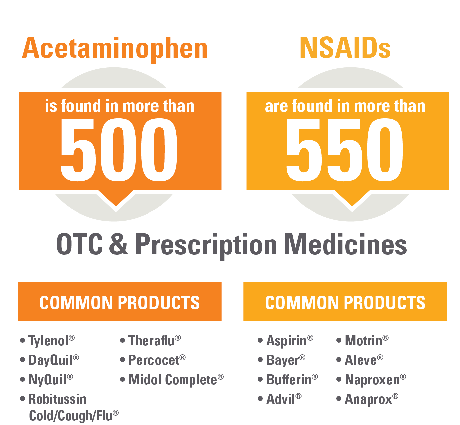
Read the label of all medications--prescriptions & OTCs.
We are fortunate to have so many remedies available to us in the form of over-the-counter (OTC) drugs and prescription medications.
However, we also have a responsibility to learn how to take these medicines safely.
For example, many people are unaware of the dangers of taking the wrong dose of acetaminophen or an NSAID.
Members of my own extended family have suffered gastrointestinal damage by unknowingly taking too many NSAIDs. And while a related problem has not happened in my family, a single overdose of acetaminophen can cause permanent damage to the liver.
In fact, acetaminophen overdose is the #1 cause of liver damage in the United State.
But which medicines contain these ingredients? Here is a partial list of common medications containing acetaminophen or an NSAID:

Take only one product at a time.
Multiple products (Rx or OTC) can contain the same ingredient.
But knowledge is power, so learn how to take these and other medications safely. The American Gastroenterological Association (AGA) offers these reminders:
- Read the label of all medications--prescriptions and over the counter--and do not exceed dosing guidelines.
- Only take one product at a time containing acetaminophen or an NSAID.
- Talk with your doctor or pharmacist about your medicine use and other options for managing your pain.

Dr. Anne M. Larson
I was fortunate enough to attend a lecture by Dr. Anne M. Larson, MD, AGAF and director of the Liver Center at Swedish Medical Center in Seattle, WA.
She reports that many adults assume that over-the-counter medications are safe since they do not require a prescription. However, it's possible to exceed safe dosing if products are taken carelessly.
Dr. Larson explains: "The main reason adults intentionally exceed labeled dosage warnings is because they want instant relief from pain."
Adults with chronic pain are most likely to exceed dose.
Chronic pain might include one or more of the following: Headaches, Fever, Colds & Allergies, Toothache, Arthritis, Flu, Backaches, Hip/Joint Pain, Muscle Aches, Bursitis, Tendinitis.
I have chronic pain due to an injury in my right hip, arthritis, and lower back pain. In order to avoid unwanted side effects of medication, I try alternatives to medication such as hot or cold compresses, stretching, development of my core muscles, diaphragmatic breathing, and meditation.
If I do end up taking medication, I am very careful to read and follow labels. I even ended up getting bifocals so that I could read the small print on medicine bottles. And I talk regularly with my doctor about how to manage chronic pain.
I invite you to watch this short video below that summarizes the key points about safe dosing of acitaminophens and NSAIDs. For more information, visit http://gutcheck.gastro.org/
Talk to your doctor or pharmacist about dosage & drug interactions.
Related:
Acetaminophen Overdose Damages the Liver
Does an Aspirin a Day Keep the Cardiologist Away?

